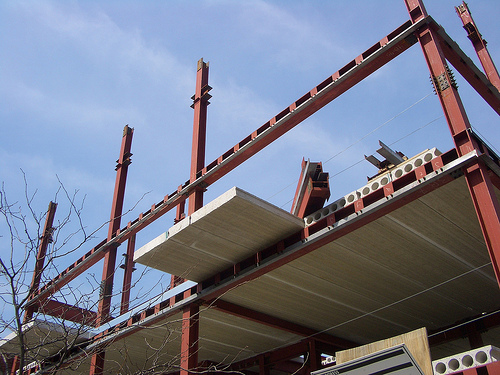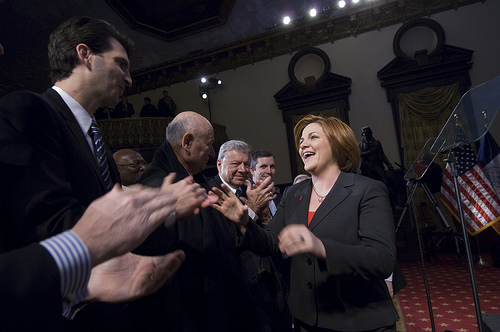It took a long time for the real estate bubble to burst in New York City — longer, it seemed, than just about everywhere else; we were still selling $45 million penthouses at the Plaza when subdivisions were going bust out in Sprawlville. Which meant that the bubble had time to stretch farther and wider than any other; prices shot up as much as 57 percent in a single year in some neighborhoods, like trendy TriBeCa.
 A condo grows in Brooklyn.Seth W via flickrBut burst it finally did, after more than 100,000 new units, most of them in the luxury condo vein, were added to the city’s famously thin housing stock. Now thousands of those high-end units remain unoccupied, thanks to the financial meltdown and the credit crisis, the suddenly shrunken crop of Wall Street execs who were their target audience. City Council speaker Christine Quinn calls the units “tarnished trophies of the building boom.”
A condo grows in Brooklyn.Seth W via flickrBut burst it finally did, after more than 100,000 new units, most of them in the luxury condo vein, were added to the city’s famously thin housing stock. Now thousands of those high-end units remain unoccupied, thanks to the financial meltdown and the credit crisis, the suddenly shrunken crop of Wall Street execs who were their target audience. City Council speaker Christine Quinn calls the units “tarnished trophies of the building boom.”
The problem is especially visible here in my home borough of Brooklyn, where glittering towers threaten to transform the very nature of the place people were so keen to move to in the last five years. Amid the brownstones, these skyscrapers now stand half-empty, like vertical architectural graveyards.
So Quinn has a Robin Hood-esque plan, an ultimate salvage and recycling strategy: wrest those units from their developers and add them to the city’s shoddy supply of housing for lower-income residents. After all, affordable housing is a key, if often overlooked, aspect of urban sustainability. “These vacant apartments now represent our best asset in the fight for affordable housing,” Quinn said at her State of the City address in February. She calls it the Affordable Housing Recovery Program. New York State Assemblyman Hakeem Jeffries is pressing his own version of the plan, which he calls Project Reclaim.
 New York City Council Speaker Christine Quinn gladhands after the address in which she floated the housing buyout plan.William Alatriste/New York City CouncilUnder Quinn’s vision, the city would use already budgeted capital funds to purchase vacant and unfinished units from developers and offer them to low- and middle-income families to rent or purchase. Per one report, a family of four could qualify if they earned somewhere between 80 percent and 150 percent of the annual area median income, taking in $61,440 to $115,000 a year. It’s a cousin of another City Council plan to buy and rehab foreclosed homes for middle-income folk, to prevent these vacancies, whether they’re in the ghetto or on 5th Avenue, from leading to blight, drops in property values, or even — heaven forbid — bad press. No matter how many vacancies we have, we don’t want to be associated with that old, pre-Giuliani New York City, of course.
New York City Council Speaker Christine Quinn gladhands after the address in which she floated the housing buyout plan.William Alatriste/New York City CouncilUnder Quinn’s vision, the city would use already budgeted capital funds to purchase vacant and unfinished units from developers and offer them to low- and middle-income families to rent or purchase. Per one report, a family of four could qualify if they earned somewhere between 80 percent and 150 percent of the annual area median income, taking in $61,440 to $115,000 a year. It’s a cousin of another City Council plan to buy and rehab foreclosed homes for middle-income folk, to prevent these vacancies, whether they’re in the ghetto or on 5th Avenue, from leading to blight, drops in property values, or even — heaven forbid — bad press. No matter how many vacancies we have, we don’t want to be associated with that old, pre-Giuliani New York City, of course.
Developers seem to tentatively approve of this new scheme, which is still in the detail-deciding phase (lawmakers haven’t yet announced a start date), but none interviewed in the local press vowed to take the city up on its eventual offer. Presumably, they’re still dreaming of a market recovery that will allow them to recoup $700 per square foot.
One other slight problem with the plan: it willfully ignores the market argument that flooding the floor with units will naturally lower rents. This is already happening; the Real Estate Board of New York reported that the average condo sales price was $1.16 million in early 2009, a 10 percent drop from the year before. According to the real estate research firm REIS, vacancy rates in the New York metro area increased 1.1 percent in 2009’s first quarter, the first rise in over a decade.
Still, the city has consistently had a vacancy rate of less than 3 percent, hence the continuing rent stabilization laws … and those, developers and landlords emphatically object to. How well the city would manage thousands of units remains a mystery, too — when it increased its holdings in the ’80s and ’90s, the city became known as the “landlord of last resort.”
In the meantime, the buildings are still working at creative marketing techniques. They host Dean and Deluca-catered brunches and wine-and-cheese events to coax potential buyers, and they continue to slash prices, though they are still far from affordable. But if they currently have a dearth of customers, one can be sure the city-owned versions of them would have plenty; many of those Wall Streeters, now collecting unemployment or waiting tables, may qualify for the subsidized units, and get to live in their fancy highrises after all.




